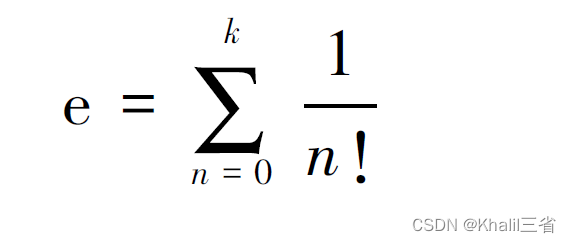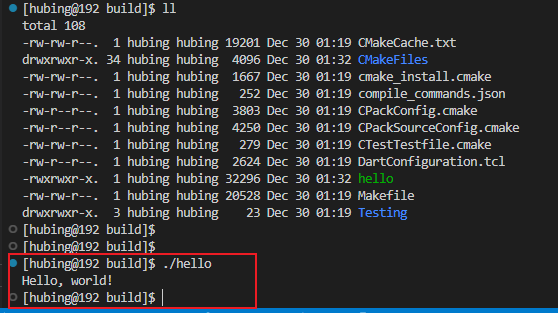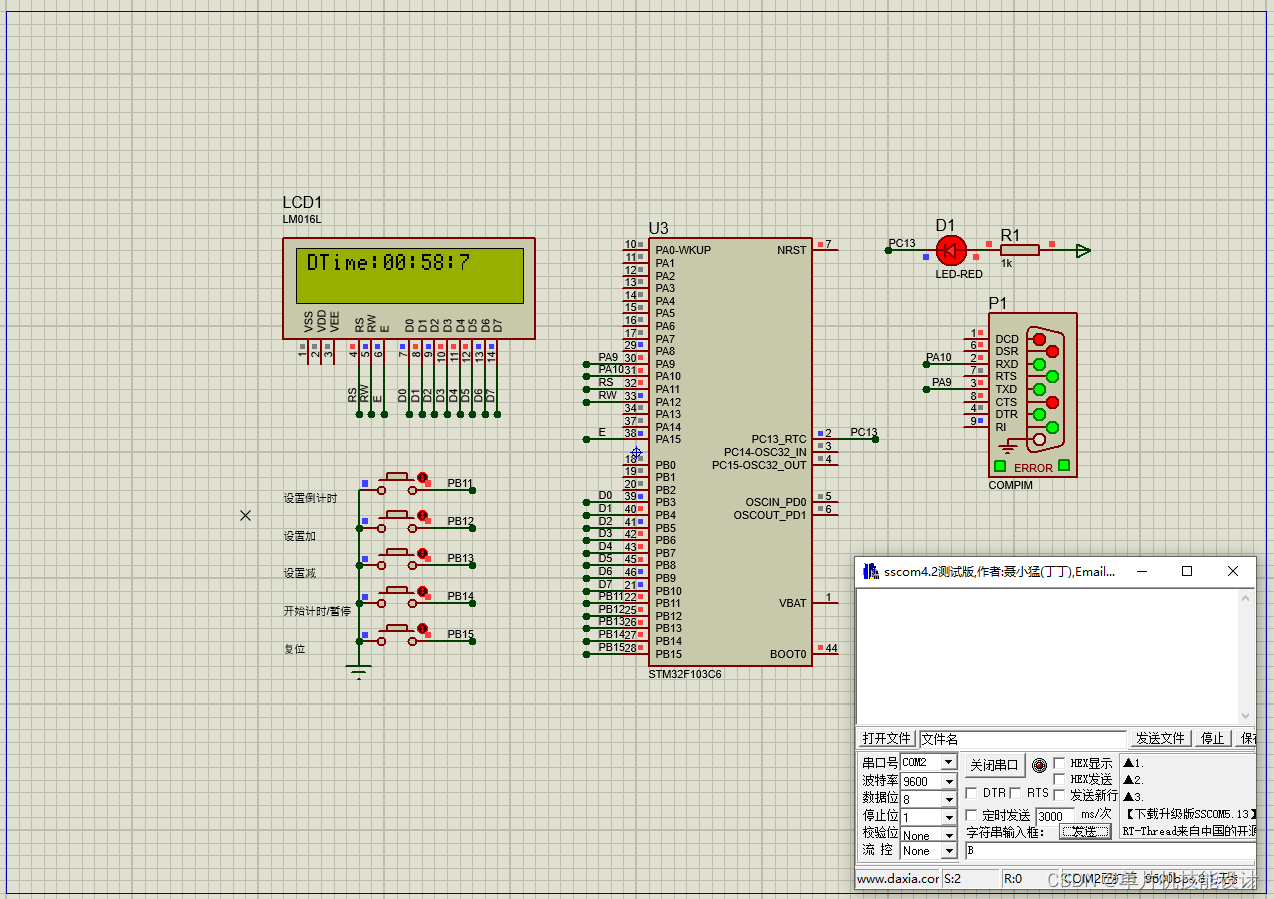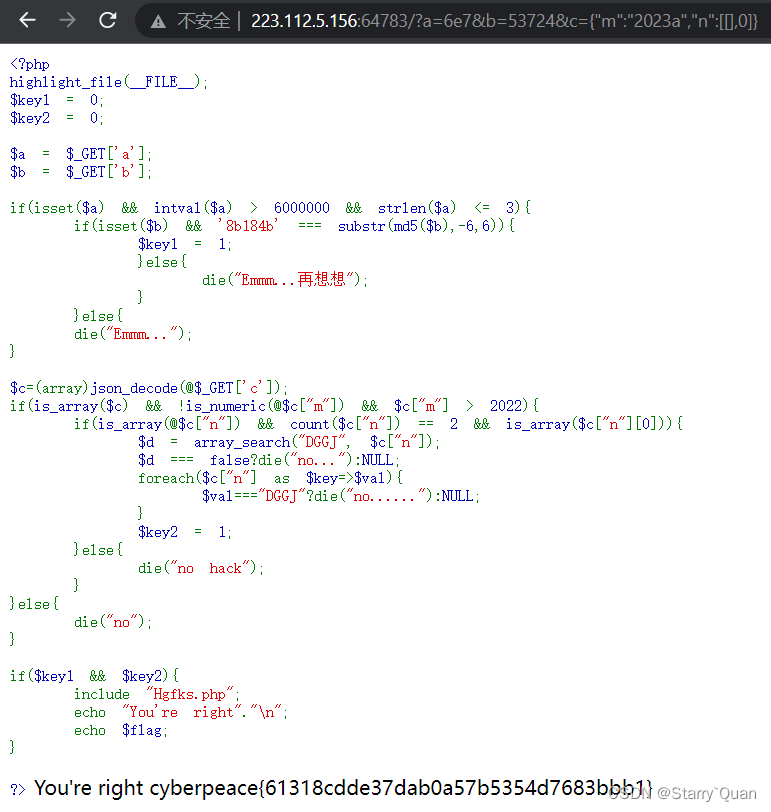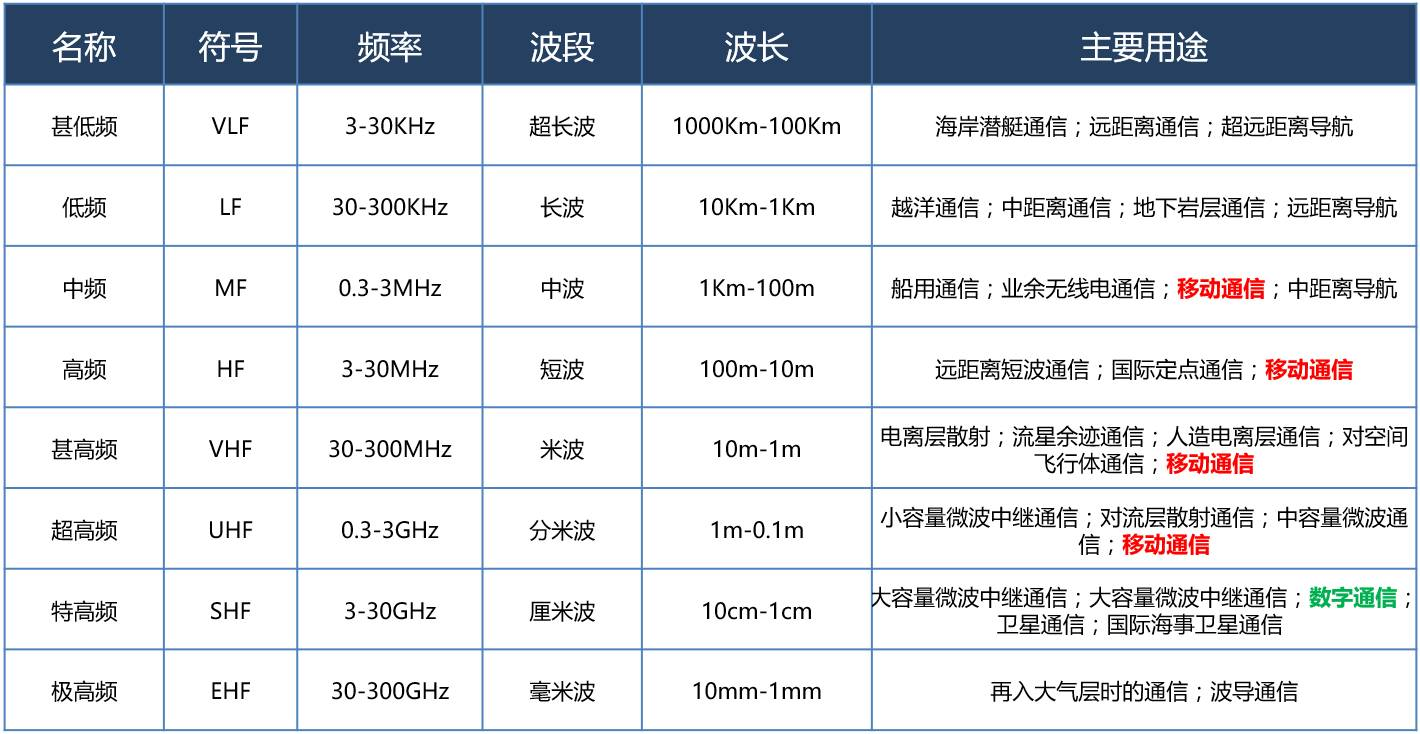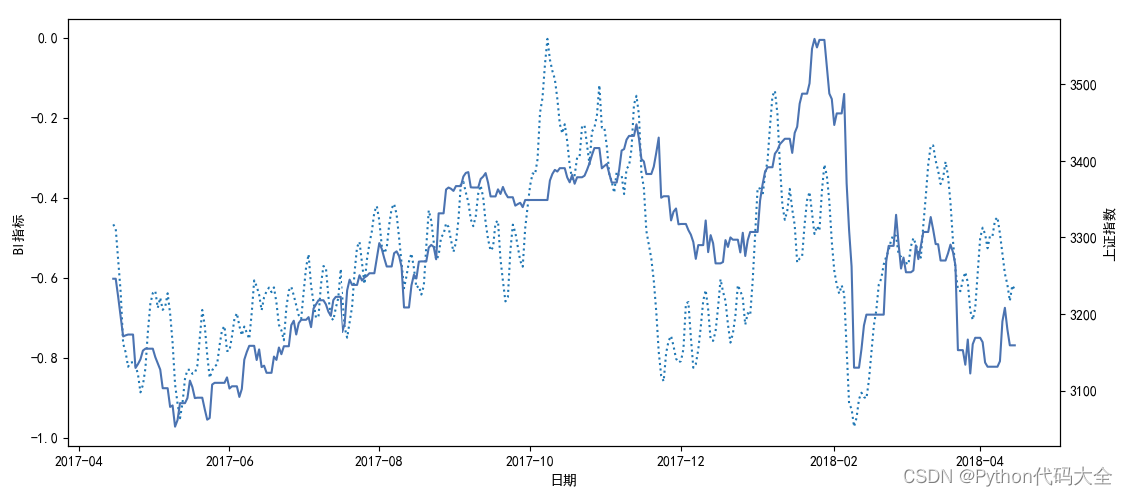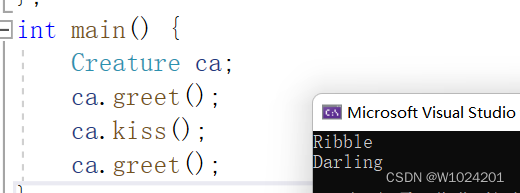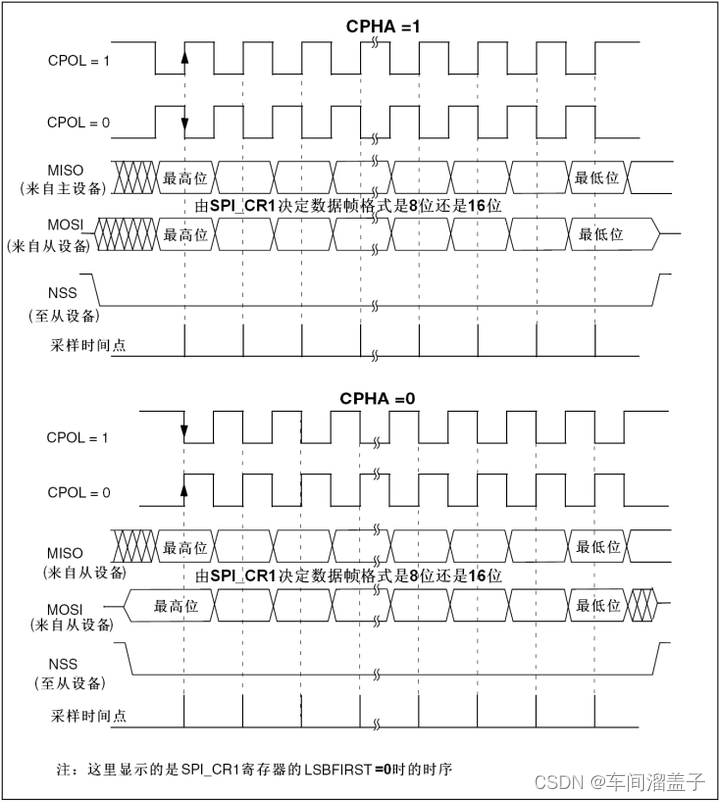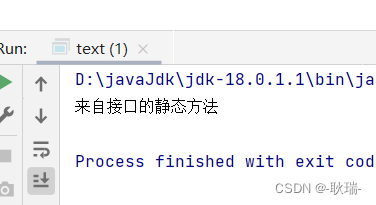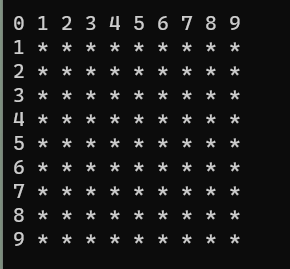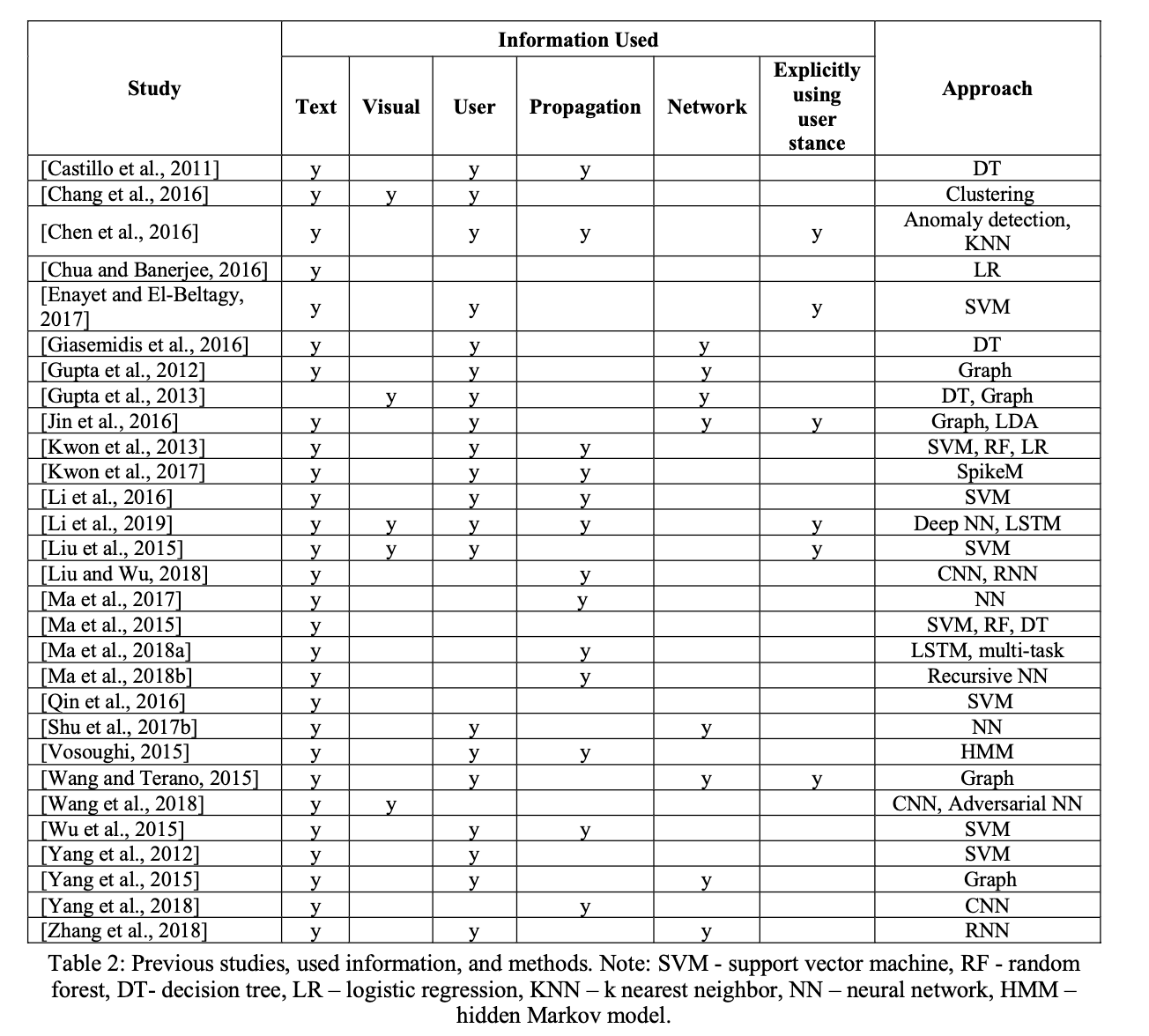1. 概述
在之前的文章中,我们介绍了HashMap1.7的源码,今天我们来看下HashMap1.8的源码。HashMap1.8相比于1.7最大的改变就是改变了1.7中采用数组+链表的方式存储键值对,转而由数组+链表+红黑树的方式来存储键值对。HashMap1.8的底层结构如下图所示:
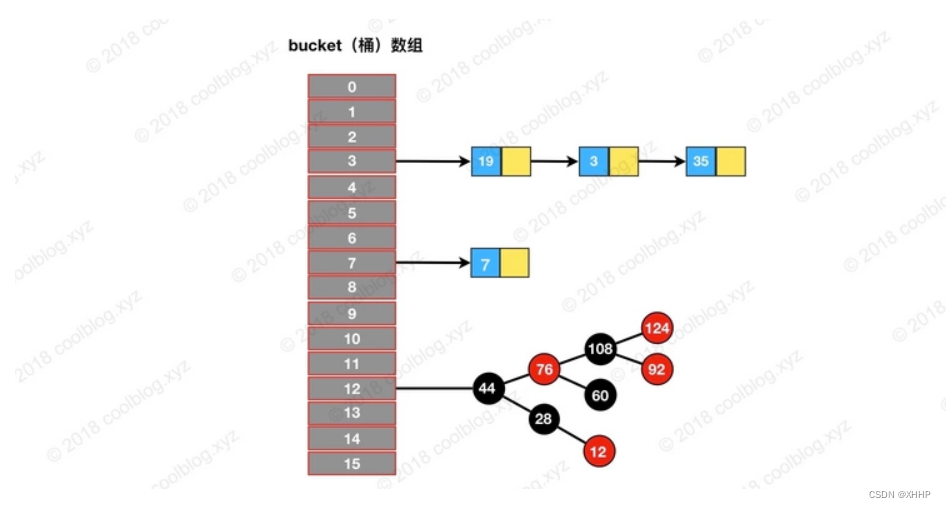
当链表中结点数较少(小于8)的时候,还是采用数组+链表的方式。当链表中结点过多,就会造成查找效率低下的情况,就会转而采用数组+红黑树的方式。
2. 成员变量
// 链表结点类
static class Node<K,V> implements Map.Entry<K,V> {
final int hash;
final K key;
V value;
Node<K,V> next;
}
// 红黑树结点类
static final class TreeNode<K,V> extends LinkedHashMap.Entry<K,V> {
TreeNode<K,V> parent; // red-black tree links
TreeNode<K,V> left;
TreeNode<K,V> right;
TreeNode<K,V> prev; // needed to unlink next upon deletion
boolean red;
}
HashMap1.8相比于1.7,多增加了红黑树结点类,用于红黑树的构建。
// 默认容量是16
static final int DEFAULT_INITIAL_CAPACITY = 1 << 4; // aka 16
// 最大容量
static final int MAXIMUM_CAPACITY = 1 << 30;
// 默认负载因子
static final float DEFAULT_LOAD_FACTOR = 0.75f;
// 当某个链表上结点数目超过8,就会将这个链表转换成红黑树
static final int TREEIFY_THRESHOLD = 8;
// 当某个红黑树上结点数目小于6,又会将红黑树转换回链表
static final int UNTREEIFY_THRESHOLD = 6;
// 最小树化容量。当键值对个数没有超过这个值时,优先进行扩容,而不是转换成红黑树
static final int MIN_TREEIFY_CAPACITY = 64;
// 数组作为桶,永远都是2的幂次方
transient Node<K,V>[] table;
// 存储元素的集合
transient Set<Map.Entry<K,V>> entrySet;
// 键值对的个数
transient int size;
// 修改次数。线程不安全的时候,启用fail-fast机制
transient int modCount;
// 阈值
int threshold;
// 实际的负载因子
final float loadFactor;
成员变量和HashMap1.7中的成员变量大体上差不多。需要注意的是UNTREEIFY_THRESHOLD和MIN_TREEIFY_CAPACITY这两个成员变量在HashMap1.7中是没有的。
3. 构造方法
// 两个参数的构造方法
public HashMap(int initialCapacity, float loadFactor) {
// 初始容量不符合范围
if (initialCapacity < 0)
throw new IllegalArgumentException("Illegal initial capacity: " +
initialCapacity);
// 如果初始化容量超过了最大容量,就设置成最大容量
if (initialCapacity > MAXIMUM_CAPACITY)
initialCapacity = MAXIMUM_CAPACITY;
// 检查负载因子的合法性
if (loadFactor <= 0 || Float.isNaN(loadFactor))
throw new IllegalArgumentException("Illegal load factor: " +
loadFactor);
// 设置负载因子
this.loadFactor = loadFactor;
// 设定阈值为初始容量
this.threshold = tableSizeFor(initialCapacity);
}
// 将容量修正为2的n次幂
static final int tableSizeFor(int cap) {
int n = cap - 1;
n |= n >>> 1;
n |= n >>> 2;
n |= n >>> 4;
n |= n >>> 8;
n |= n >>> 16;
return (n < 0) ? 1 : (n >= MAXIMUM_CAPACITY) ? MAXIMUM_CAPACITY : n + 1;
}
// 一个参数的构造方法
public HashMap(int initialCapacity) {
this(initialCapacity, DEFAULT_LOAD_FACTOR);
}
// 无参构造方法
public HashMap() {
this.loadFactor = DEFAULT_LOAD_FACTOR; // all other fields defaulted
}
// Map迁移
public HashMap(Map<? extends K, ? extends V> m) {
this.loadFactor = DEFAULT_LOAD_FACTOR;
putMapEntries(m, false);
}
在构造方法中,我们可以看到并没有对于数组进行操作,所以采用的是懒加载的方法,当进行put的时候才会创建数组。此外,可以看到HashMap1.8利用tableSizeFor方法让容量规范为2的n次幂,具体原因可见HashMap初始容量为什么是2的n次幂及扩容为什么是2倍的形式。
4. put方法
// put接口方法
public V put(K key, V value) {
// 先计算hash值,然后putVal
return putVal(hash(key), key, value, false, true);
}
// 通过扰动函数减少hash碰撞
static final int hash(Object key) {
int h;
return (key == null) ? 0 : (h = key.hashCode()) ^ (h >>> 16);
}
final V putVal(int hash, K key, V value, boolean onlyIfAbsent,
boolean evict) {
Node<K,V>[] tab; Node<K,V> p; int n, i;
// 如果还没有创建数组,就调用resize方法创建数组
if ((tab = table) == null || (n = tab.length) == 0)
n = (tab = resize()).length;
// 通过模运算计算插入的位置,如果为null,就直接插入
if ((p = tab[i = (n - 1) & hash]) == null)
tab[i] = newNode(hash, key, value, null);
else {
Node<K,V> e; K k;
// 如果桶的第一个位置就是要找的key
if (p.hash == hash &&
((k = p.key) == key || (key != null && key.equals(k))))
e = p;
// 如果当前桶是一颗红黑树,就插入到红黑树中
else if (p instanceof TreeNode)
e = ((TreeNode<K,V>)p).putTreeVal(this, tab, hash, key, value);
else { // 如果当前桶是链表
for (int binCount = 0; ; ++binCount) { // bitCount计算节点个数
// 找到末尾都没有找到,则用尾插法插入到链表末尾
if ((e = p.next) == null) {
p.next = newNode(hash, key, value, null);
if (binCount >= TREEIFY_THRESHOLD - 1) // 如果节点数量超过阈值,就转化成红黑树
treeifyBin(tab, hash);
break;
}
// 找到了一样的key,就直接覆盖
if (e.hash == hash &&
((k = e.key) == key || (key != null && key.equals(k))))
break;
p = e;
}
}
if (e != null) { // 如果找到了一样的key,返回旧值
V oldValue = e.value;
if (!onlyIfAbsent || oldValue == null)
e.value = value;
afterNodeAccess(e);
return oldValue;
}
}
++modCount;
if (++size > threshold) // 大于阈值
resize(); // 进行扩容操作
afterNodeInsertion(evict);
return null;
}
put方法整体流程不是很复杂,我们总结下:
- 通过扰动函数计算key的hash值;
- 检查是否创建数组,没有创建就先进行创建;
- 通过模运算计算出要插入的位置,然后根据下面流程检查,选择一种情况;
- 如果要插入的位置为空,就直接插入;
- 如果要插入的位置第一个节点和要插入的key一样,那就覆盖;
- 如果是红黑树,就插入到红黑树中;
- 如果是链表节点,找到了一样的key就直接覆盖,没找到就插入在链表的末尾。节点过多就转换成红黑树;
- 检查是否需要进行扩容;
过程如下图所示:
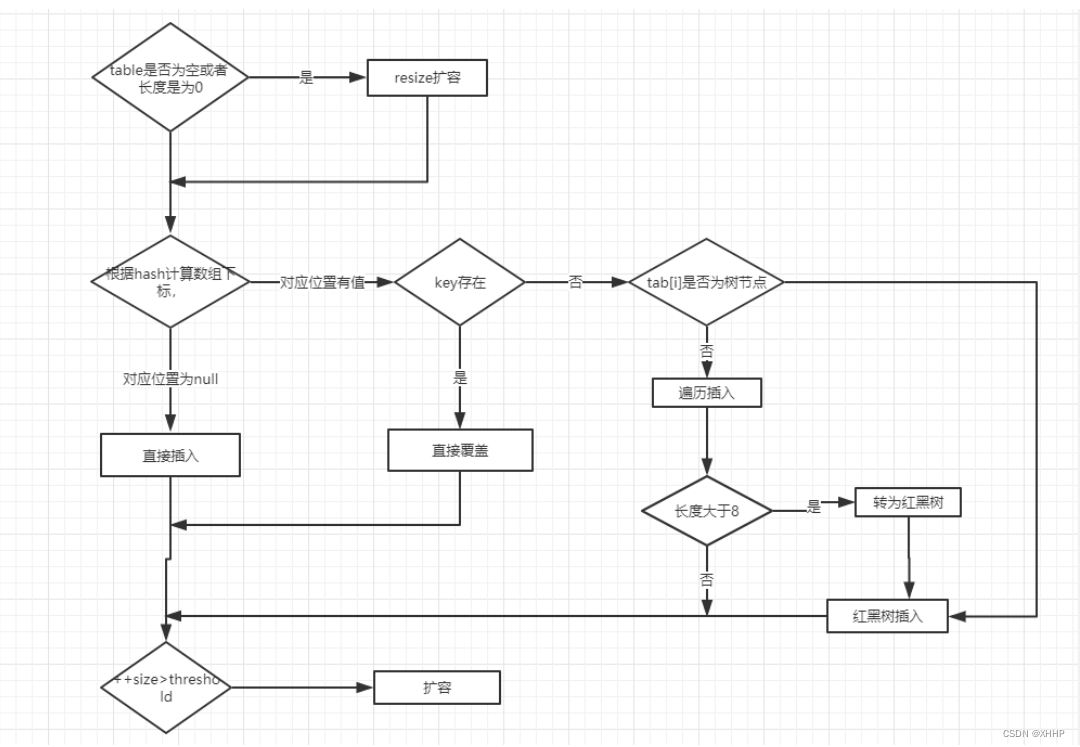
5. resize方法
final Node<K,V>[] resize() {
Node<K,V>[] oldTab = table; // 旧数组
int oldCap = (oldTab == null) ? 0 : oldTab.length; // 旧容量
int oldThr = threshold; // 旧阈值
int newCap, newThr = 0;
if (oldCap > 0) { // 如果旧容量大于0
if (oldCap >= MAXIMUM_CAPACITY) { // 已经达到最大容量就不扩容
threshold = Integer.MAX_VALUE;
return oldTab;
}
// 否则扩容为原来的两倍
else if ((newCap = oldCap << 1) < MAXIMUM_CAPACITY &&
oldCap >= DEFAULT_INITIAL_CAPACITY)
newThr = oldThr << 1; // double threshold
}
else if (oldThr > 0) // 阈值初始化了,容量没有初始化
newCap = oldThr; // 旧阈值成为新容量
else { // 容量和阈值都没有初始化,就采用默认的
newCap = DEFAULT_INITIAL_CAPACITY;
newThr = (int)(DEFAULT_LOAD_FACTOR * DEFAULT_INITIAL_CAPACITY);
}
if (newThr == 0) { // 计算新的阈值
float ft = (float)newCap * loadFactor;
newThr = (newCap < MAXIMUM_CAPACITY && ft < (float)MAXIMUM_CAPACITY ?
(int)ft : Integer.MAX_VALUE);
}
threshold = newThr;
@SuppressWarnings({"rawtypes","unchecked"})
Node<K,V>[] newTab = (Node<K,V>[])new Node[newCap]; // 创建新数组
table = newTab;
if (oldTab != null) {
for (int j = 0; j < oldCap; ++j) { // 遍历旧数组
Node<K,V> e;
if ((e = oldTab[j]) != null) {
oldTab[j] = null; // 取出第j个桶
if (e.next == null) // 如果只有一个节点,就直接搬到新数组
newTab[e.hash & (newCap - 1)] = e;
else if (e instanceof TreeNode) // 如果是树节点,就重建树
((TreeNode<K,V>)e).split(this, newTab, j, oldCap);
else { // 如果是链表节点
// 低位链表的头节点和尾节点
Node<K,V> loHead = null, loTail = null;
// 高位链表的头节点和尾节点
Node<K,V> hiHead = null, hiTail = null;
Node<K,V> next;
do {
next = e.next;
if ((e.hash & oldCap) == 0) { // 构建低位链表
if (loTail == null)
loHead = e;
else
loTail.next = e;
loTail = e;
}
else { // 构建高位链表
if (hiTail == null)
hiHead = e;
else
hiTail.next = e;
hiTail = e;
}
} while ((e = next) != null);
if (loTail != null) { // 低位链表放入新数组
loTail.next = null;
newTab[j] = loHead;
}
if (hiTail != null) { // 高位链表放入新数组
hiTail.next = null;
newTab[j + oldCap] = hiHead;
}
}
}
}
}
return newTab; // 返回新数组
}
在HashMap1.8的扩容方法中,采用的是尾插法的方式,就避免了在HashMap1.7中的死循环问题。此外,在进行节点迁移的时候,划分了低位链表和高位链表,这是设计者的巧妙设计,使得在进行查找的时候能够准确找到节点。具体可见HashMap扩容时的rehash方法中(e.hash & oldCap) == 0算法推导。
我们对于resize方法的流程梳理一下:
- 如果旧数组已经是最大容量,那就不进行扩容,否则扩容为原来的两倍。
- 如果就数组没有初始化过,就采用默认的容量进行初始化。
- 之后就进行节点的迁移,通过低位链表和高位链表的方式将节点迁移到新数组上。
6. get方法
// get方法
public V get(Object key) {
Node<K,V> e;
// 计算hash值后调用getNode方法获取节点
return (e = getNode(hash(key), key)) == null ? null : e.value;
}
// 获取节点的方法
final Node<K,V> getNode(int hash, Object key) {
Node<K,V>[] tab; Node<K,V> first, e; int n; K k;
// 根据hash值找到指定的桶
if ((tab = table) != null && (n = tab.length) > 0 &&
(first = tab[(n - 1) & hash]) != null) {
if (first.hash == hash && // always check first node
((k = first.key) == key || (key != null && key.equals(k)))) // 如果第一个节点就找到了,就直接返回
return first;
if ((e = first.next) != null) { // 继续在桶中寻找
if (first instanceof TreeNode) // 如果是红黑树
return ((TreeNode<K,V>)first).getTreeNode(hash, key);
do { // 如果是链表
if (e.hash == hash &&
((k = e.key) == key || (key != null && key.equals(k)))) // 找到就返回
return e;
} while ((e = e.next) != null);
}
}
return null;
}
get方法比较简单,就是根据hash值确定具体的桶,然后在桶中寻找即可。
7. remove方法
// remove方法
public V remove(Object key) {
Node<K,V> e;
// 计算hash值后调用removeNode方法删除节点
return (e = removeNode(hash(key), key, null, false, true)) == null ?
null : e.value;
}
// 删除节点的方法
final Node<K,V> removeNode(int hash, Object key, Object value,
boolean matchValue, boolean movable) {
Node<K,V>[] tab; Node<K,V> p; int n, index;
// 根据hash值计算出具体的桶
if ((tab = table) != null && (n = tab.length) > 0 &&
(p = tab[index = (n - 1) & hash]) != null) {
Node<K,V> node = null, e; K k; V v;
// 桶中的第一个节点就是
if (p.hash == hash &&
((k = p.key) == key || (key != null && key.equals(k))))
node = p;
else if ((e = p.next) != null) {
if (p instanceof TreeNode) // 红黑树中搜索
node = ((TreeNode<K,V>)p).getTreeNode(hash, key);
else {
do { // 链表节点中遍历搜索
if (e.hash == hash &&
((k = e.key) == key ||
(key != null && key.equals(k)))) {
node = e;
break;
}
p = e;
} while ((e = e.next) != null);
}
}
// 如果找到了要删除的节点
if (node != null && (!matchValue || (v = node.value) == value ||
(value != null && value.equals(v)))) {
if (node instanceof TreeNode) // 红黑树中删除
((TreeNode<K,V>)node).removeTreeNode(this, tab, movable);
else if (node == p) // 如果是头节点
tab[index] = node.next;
else // 如果是中间节点
p.next = node.next;
++modCount;
--size;
afterNodeRemoval(node);
return node;
}
}
return null; // 没找到
}
remove方法也不难,找到具体的桶,然后遍历桶中的键值对,找到删除即可。
8. HashMap1.7和HashMap1.8对比
最后我们来将1.7版本和1.8版本进行对比:
- 1.7版本在插入元素的时候采用头插法,可能会出现死循环的问题。1.8版本插入元素采用尾插法,避免死循环问题;
- 1.7版本采用的是数组+链表的方式,当链表节点过多的时候,查询效率会降低。1.8版本引入红黑树,提高查询效率;
- 但是两者都不是线程安全的。
参考文章:
史上最详细的 JDK 1.8 HashMap 源码解析
Hashmap的结构,1.7和1.8有哪些区别

